ISSN ONLINE(2278-8875) PRINT (2320-3765)
ISSN ONLINE(2278-8875) PRINT (2320-3765)
Pardeep Singh Virk1, Vijay Kumar Garg2
|
| Related article at Pubmed, Scholar Google |
Visit for more related articles at International Journal of Advanced Research in Electrical, Electronics and Instrumentation Engineering
Power system stability is defined as the ability of power system to preserve it’s steady stability or recover the initial steady state after any deviation of the system’s operation. This paper investigates the effects of Static Var Compensator (SVC) on voltage stability of a power system. This paper will discuss and demonstrate how SVC has successfully been applied to power system for effectively regulating system voltage. Present time power systems are being operated nearer to their stability limits due to economic and environmental reasons. Maintaining a stable and secure operation of a powersystem is therefore a very important and challenging issue. Shunt FACTS devices play an important role in improving the transient stability, increasing transmission capacity and damping low frequency oscillations. In this paper shunt FACTS device-SVC is used in a two machine system for improving the power system stability. MATLAB software has been used in this study.
Keywords |
| FACTS, long transmission line, MATLAB, SVC, power system stability, three phase fault. |
INTRODUCTION |
| Transmission networks of present power systems are becoming progressively more stressed because of increasing demand and limitations on building new lines. In recent years, greater demands have been placed on the transmission network, and these demands will continue to increase because of the increasing number of non utility generators and heightened competition among utilities themselves. Flexible Alternating Current Transmission Systems (FACTS) are new devices emanating from recent innovative technologies that are capable of altering voltage, phase angle and/or impedance at particular points in power systems. Their fast response offers a high potential for power system stability enhancement apart from steady state flow control. Among the FACTS controllers, Static Var Compensator (SVC) provides fast acting dynamic reactive compensation for voltage support during contingency events. Static Var Compensators (SVC) devices are used to improve voltage and reactive power conditions in AC systems. It also increases transmission capacity as result of power oscillation damping. The effectiveness of this controller depends on its optimal location and proper signal selection in the power system network.[1] |
II. POWER SYSTEM STABILITY |
A. Definition of Stability of a System |
| The stability of a system is defined as the tendency and ability of the power system to develop restoring forces equal to or greater than the disturbing forces to maintain the state of equilibrium [2]. Let a system be in some equilibrium state. If upon an occurrence of a disturbance and the system is still able to achieve the equilibrium position, it is considered to be stable. The system is also considered to be stable if it converges to another equilibrium position in the proximity of initial equilibrium point. If the physical state of the system differs such that certain physical variable increases with respect to time, the system considered to be unstable .Therefore, the system is said to remain stable when the forces tending to hold the machines in synchronism with one another are enough to over -come the disturbances .The system stability that is of most concern is the characteristic and the behavior of the power system after a disturbance [2] . |
B. Need for Power System Stability |
| The power system industry is a field where there are constant changes. Power industries are restructured to cater to more users at lower prices and better power efficiency . Power systems are becoming more complex as they become inter-connected. Load demand also increases linearly with the increase in users. Since stability phenomena limits the transfer capability of the system, there is a need to ensure stability and reliability of the power system due to economic reasons .Different types of power system stability have been classified into rotor angle stability, frequency stability and voltage s tability [2]. |
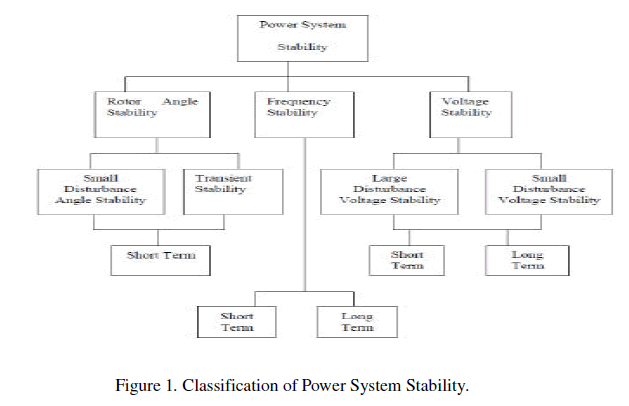 |
III. STATIC VAR COMPENSATOR |
| A. Basic SVC |
| Static var compensators (SVCs) constitute a mature technology that is finding widespread usage in modern power systems for load compensation as well as transmission-line applications. In high-power networks, SVCs are used for voltage control and for attaining several other objectives such as damping and stability control .The SVC provides an excellent source of rapidly controllable reactive shunt compensation for dynamic voltage control through its utilization of high-speed thyristor switching/controlled reactive devices. A shunt-connected static var generator or absorber whose output is adjusted to exchange capacitive or inductive current so as to maintain or control specific parameters of the electrical power system (typically bus voltage).[3] |
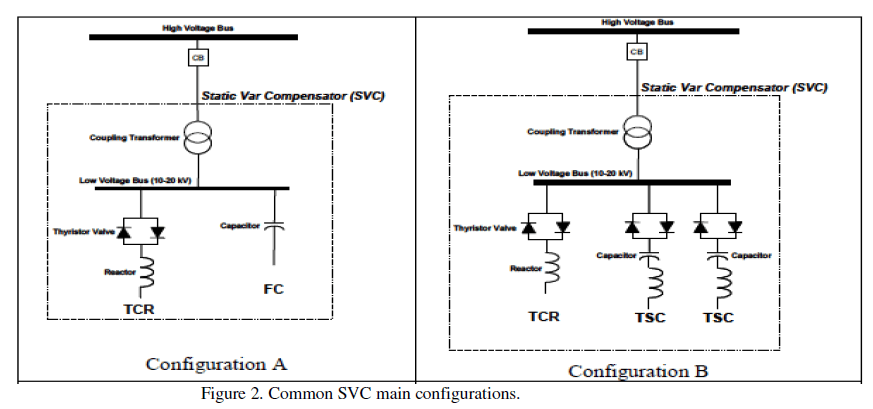 |
| By providing dynamic reactive power, svc can be used for the purpose of regulating the system voltage, compensating the voltage at reasonable level, improving the capacity of the transmission line. From the operational point of view, the SVC adjusts its value automatically in response to changes in the operating conditions of the network. By suitable control of its equivalent reactance, it is possible to regulate the voltage magnitude at the SVC point of connection, thus enhancing significantly the performance of the power system [4],[5],[6]. The SVC uses conventional thyristors to achieve fast control of shunt-connected capacitors and reactors. The configuration of the SVC is shown in Fig. 2 (a), which basically consists of a fixed capacitor (C) and a thyristor controlled reactor (L). The firing angle control of the thyristor banks determines the equivalent shunt admittance presented to the power system. |
B. SVC V-I Characteristics |
| The SVC can be operated in two different modes: |
| • In voltage regulation mode |
| • In var control mode (the SVC susceptance is kept constant) |
| When the SVC is operated in voltage regulation mode, it implements the following V-I characteristic [7]. |
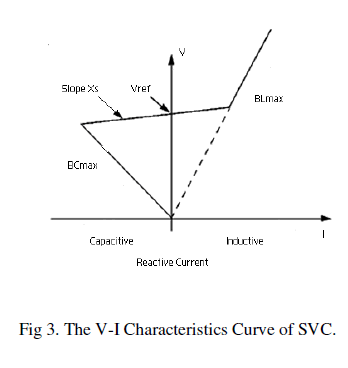 |
IV. SVC MODELLING |
| A problem has been taken of two machine model consisting of two three bus model for analysis of transients stability using MATLAB Simulation. To see the effect of the SVC in the system to stabilize the voltage wave form when the system subjected to three phase fault,a two machine system system is developed with three buses as shown in fig. 4. |
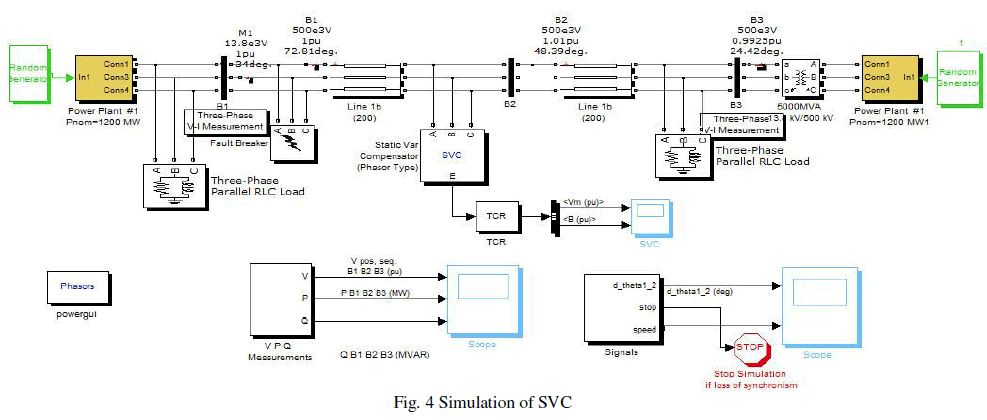 |
| Power plants are employed with random generators as shown. A stop block is used to stop the simulation. Here two different loads are connected at bus B1 and B3 of the system [8]. |
V. SIMULATION RESULTS |
| This section illustrates results of simulation of a simple transmission system containing two hydraulic power plants. A Static Var Compensator (SVC) and Power System Stabilizers (PSS) are used to improve transient stability and power oscillation damping of the system[9 ]. In this paper SVC regularly provides the necessary reactive power to control voltage swings and thereby improves transmission perfrormance [10]. The resultant simulation curves of the above MATLAB model are : Fig.5 shows the rotor angle difference with and without SVC and fig.6 shows positive sequence voltage V(pu), active power P(MW) and reactive power Q(MVar) at the buses B1,B2,B3 respectively. |
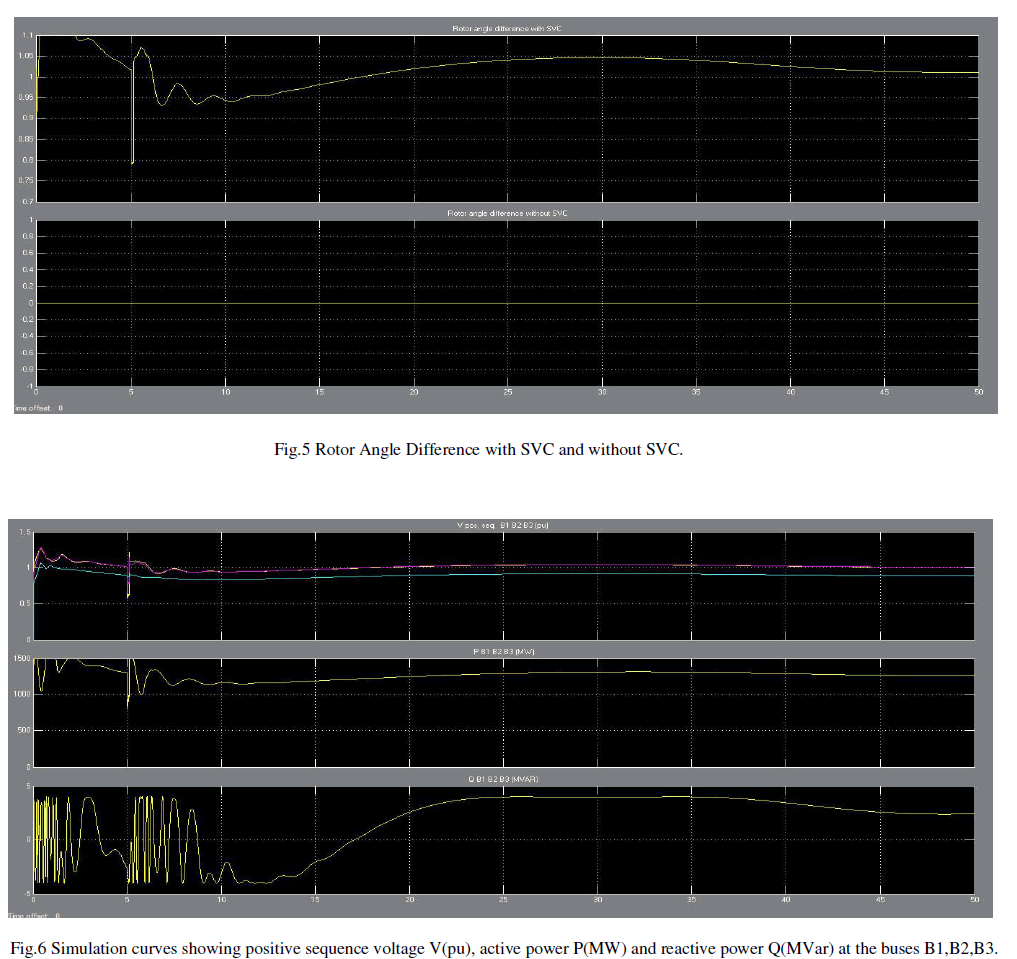 |
VI. CONCLUSION |
| It is known that the SVCs with an auxiliary injection of a suitable signal can considerably improve the dynamic stability performance of a power system. Therefore SVCs have been applied successfully to improve the transient stability of a synchronous machine [11]. This paper presents the stability improvement of voltage level and real & reactive power in a power system model containing SVC [12]. Simulations carried out confirm that SVC could provide the fast acting voltage support necessary to prevent the possibility of voltage reduction and voltage collapse. Analysis of SVC reactive power output (pu) in response to voltage steps is presented in this paper. This paper inspects actual positive sequence voltage in a system model with or without SVC. |
References |
|